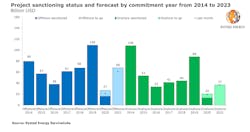Project sanctioning to decline by more than 75%, analyst claims
Offshore staff
OSLO, Norway – Global project sanctioning is set to decline this year by more than 75% from 2019 levels, as the COVID-19 pandemic has caused E&P spending to drop much lower than what was expected at the beginning of the crisis. Rystad Energy estimates total sanctioning value will end up at around $47 billion, an amount that would be even lower if not for recent developments in Norway and Russia.
Of total global sanctioning value in 2020, some $27 billion is expected to be for offshore projects, with the remaining $20 billion for onshore. In 2019, the total sanctioning value reached $197 billion, with $109 billion going to offshore projects and $88 billion to onshore projects.
So far this year, the projects that have been committed are worth a combined $29 billion, with $16 billion going to offshore and the remaining going to onshore. The analyst’s forecast is based on a scenario in which Brent averages around $40/bbl this year, not far from its current market price.
Karan Satwani, energy service analyst, said: “At the beginning of this year, the project commitments forecast for 2020 were expected to be comparable to 2019, but the industry downturn thanks to COVID-19 has caused commitments to fall sharply. Going forward, Rystad Energy estimates that sanctioning will not pick up again and recover to 2019 levels anytime soon.”
On a positive note, a month ago total sanctioning was projected even lower than what is now anticipated, as developments in Norway and Russia have given total estimated levels a boost in the analyst’s July update.
Gazprom awarded contracts for phase one of its Kamennomysskoye-More project at the Sevmash and Zvezdochka yards, both managed by United Shipbuilding Corp. The contracts are for the construction of the foundation of an ice-resistant platform, with the design job outsourced to engineering player Karoll. Rystad estimates the first phase of the development will cost more than $4 billion.
Meanwhile, the tax relief package announced by the Norwegian government last month has helped oil and gas operators improve project economics in Norway. Spurred by the program, Aker BP started development activities on its Hod redevelopment project by awarding Kvaerner a $106-million contract for the topsides and steel substructure of an unmanned wellhead platform, and the subsea pipelines and umbilicals contract to Subsea 7 in a deal valued between $50 million and $150 million.
Equinor also signed the letter of intent last month for both the Breidablikk and Askeladd West projects offshore Norway. The Breidablikk development, which includes the Grane D and Grane E fields, will be developed as a subsea tieback to the Grane platform and is expected to cost nearly $2 billion. Aker Solutions has been awarded a letter of intent to supply the subsea production system and associated equipment, which includes 15 subsea trees in a deal worth $206 million.
Aker Solutions has also received a letter of intent for the subsea production system at the Askeladd West development, valued at $41 million. The scope includes two subsea trees and one template with a manifold and associated equipment. The development of Askeladd West is phase two of the multi-phased Snøhvit gas development project. TechnipFMC was awarded a letter of intent for the subsea installation work for both projects.
However, the letters of intent for both projects are subject to a final investment decision, which the operator plans to take later this year.
Lastly, LLOG Exploration has taken a final investment decision for the Taggart deepwater development in the US Gulf of Mexico. The development plan includes tiebacks for two existing wells to the Williams-operated Devils Tower spar. Williams has reached a tieback agreement with LLOG to provide offshore natural gas and oil gathering and production handling services for the development at the platform. Rystad estimates the development will cost more than $300 million.
07/17/2020
